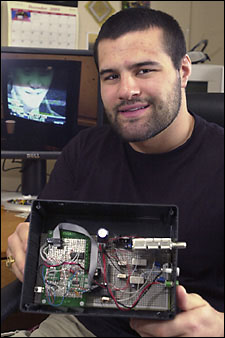DEAS student makes cableless cable
Wireless cable and a cleaner climate garner top prizes for design projects
Shows from the “Sopranos” to “Celebrity Poker” may soon be plucked right out of the air thanks to wireless (wi-fi) technology and the ingenuity of a Harvard senior.

Matthew DePetro ’05, an EECS-track Engineering Sciences (SB) concentrator at the Division of Engineering and Applied Sciences (DEAS), earned top honors for his ES100-100hf senior design project, “Wireless Cable Television.” Presented earlier this month to a panel of DEAS faculty judges, the first-prize entry “untethers” standard cable TV and even eliminates the need for a wall outlet.
“All of the rooms that I have lived in at Harvard have such crummy standard TV reception that something as simple as watching the 11 o’clock news is an unfulfilling experience,” says DePetro. “Unfortunately, cable television service suffers from the inherent shackles of a cable for signal distribution. In a typical dorm residence that means television sets must be located near a cable outlet in the wall.”
Moreover, setting up cable for multiple sets in separate rooms requires adding extra wiring infrastructure within a building itself – no easy feat in older structures. This costly add-on hints at why residents in large living units, such as college dorms, typically huddle around a central set rather than watch shows from the comfort of their own pads.
The solution to gaining a greater variety of programming and better reception, was, bad pun intended, in the air. With the help of his adviser, Assistant Professor of Electrical Engineering Donhee Ham, DePetro exploited the same wi-fi technology that allows laptop users to instantly go online indoors or out. He transmitted the cable TV signal from a single wall point to free-roaming locations within a residence.
“Wirelessly broadcasting the cable television spectrum in its entirety, however, is not feasible because there’s not enough free bandwidth in the air,” explains DePetro. He overcame that obstacle by tuning an individual channel at a base transmitter and then broadcasting only that channel to a special receiver device.
To change a channel a separate signal is sent from the receiver module to the base transmitter to control the tuner. The result: the entire cable spectrum is available for viewing, wirelessly, one channel at a time. With broadcasts no longer wall- or wire-bound, individual rooms could one day be made cable-ready cheaply and quickly.
“I would actually love to commercialize this device, but it would require a partnership with an industry presence and further development and advancement to polish it off and prepare it for the consumer market,” says DePetro.
His postgrad plans may mean desperate dorm dwellers will likely have a long wait for a clear signal. The senior, who counts football, “South Park,” and documentaries on the History Channel among his favorite TV fare, is slated to work in Tokyo designing supercomputers for Fujitsu.
Second prize went to a project that took a different approach to assessing the air. “An Integrated System to Measure the Effects of Selective Logging on Coarse Woody Debris Stocks in a Northern Temperate Forest” by Dan Curran ’05, an Engineering Sciences (SB) concentrator, focused on improving the instrumentation for analyzing the role of coarse woody debris (CWD) in the carbon cycle of forests.
“Understanding the dynamics of such natural litter on the forest floor, and how it is affected by human activities such as logging, is critical for determining the role forests play in the carbon cycle and in global climate change,” explains Curran.
To allow automated and continuous measurements of CWD stocks, he enhanced an existing tool used in the Harvard Forest (3,000 acres of land in Petersham, Mass.) by his adviser, Abbott Lawrence Rotch Professor of Atmospheric and Environmental Science Steve Wofsy. Curran’s main innovations included reducing the device’s power consumption, increasing its measurement replication by changing the sampling rates, and creating a custom method for measuring wood moisture content.
“This instrumentation should provide researchers with the tools to gather important information necessary for making informed policy decisions on how forests should be managed to help slow the increase of carbon dioxide levels in the atmosphere,” says Curran.
The two winning projects – along with other presentations that included a machine for safer strength training, a smart cash register that counts bills, a programmable funhouse mirror, and a propulsion system for surfboards – highlighted the practical, personal, and delightful inventiveness of DEAS students.




